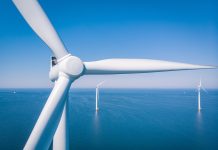Wind farm developers understand the critical nature of providing adequate foundation support in advance of erecting towers, since soft soils can lead to poor performance or a catastrophic collapse. And as land-based farms grow increasingly remote, reaching the erection site has become more challenging as well. Luckily Geopier Foundation Company (GFC) and the Tensar International Corporation (TIC)—sister companies within The Tensar Corporation’s umbrella—are in a position to offer solutions for both situations.
Founded in 1989 and based in Mooresville, North Carolina—it was acquired by The Tensar Corporation in 2002—GFC is a developer of the Rammed Aggregate Pier® (RAP) systems. These efficient and cost-effective Intermediate Foundation® solutions are used for the support of settlement-sensitive structures such as wind towers. “Our soil reinforcement systems are installed by our local representatives, often using locally-available aggregate materials found near the project site,” according to Brendan FitzPatrick, P.E., the company’s director of engineering and development for North America. “Construction basically consists of compacting successive thin lifts of high-quality crushed rock in a shallow cavity of varying depths using our patented ramming equipment, which increases the lateral stress and improves the soils surrounding the cavity. This results in foundation settlement control and greater bearing pressures to support large tower foundations, while substantially reducing construction schedules.”
Used to reinforce good to poor soils, RAP systems are in use around the world. GFC worked with wind farm development companies overseas prior to introducing the technology on wind farms in the United States. “Early on, we were able to share our European client’s testimonials with our customers throughout North America,” FitzPatrick explains, “which was really helpful in terms of gaining their confidence.”
Although Tensar Geogrid technology was originally developed in the United Kingdom, the company’s corporate headquarters are now based in Atlanta, Georgia. As with the Geopier System, Tensar Geogrids were first adopted on wind farm projects in Europe. “Our first project in this market was in 2005 at the Maple Ridge Wind Farm in upstate New York,” says Jim Penman, director of business development for TIC. “In total we have now been involved in more than 100 such projects around the world, with just under half of them here in the U.S.”
Penman explains that, although the trucks carrying wind tower sections might seem to represent the heaviest loads, it is actually the concrete trucks that are of most concern with respect to the performance of the access roads on wind farm sites. “The concrete trucks definitely do the most damage,” he says, “so we know that if our roads can support their weight they can handle everything else as well.”
The traditional method for creating an access road to carry the regular, heavy traffic required for wind farm construction weights and withstand the related churning of the massive tires involves placing a layer of aggregate base. This can be very time consuming and expensive, particularly on sites underlain by softer soils. By including a layer of Tensar Geogrid on top of the subgrade, the required aggregate thickness for the access roads can be reduced by as much as 60 percent. “Some contractors have indicated that on sites with weaker soils, construction of the access roads can represent as much as 20 percent of the overall development cost,” he says. “A Geogrid can also be used to strengthen the aggregate used to form the crane platforms at individual tower locations.”
Although each company focuses on different aspects of wind farm development, the combined teamwork and support offered under the Tensar Corporation is to the benefit of their clients in the wind industry. “There is a very close relationship between the two companies,” FitzPatrick says. “If you’ve got a site with challenging conditions that drive the need for foundation support using our RAP systems, then you’ll likely have the need for Tensar’s Geogrid as well. No matter the challenge, we are here to help wind farm project teams solve their challenging soil issues with timely and cost-effective solutions.” – R.W.
To learn more:
Visit Geopier online at www.geopier.com, and Tensar International at www.tensarcorp.com.



























